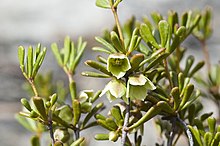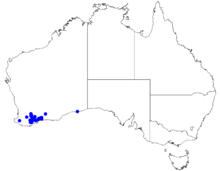| Boronia octandra | |
|---|---|

| |
| Boronia octandra in the Nuytsland Nature Reserve | |
|
Scientific classification
| |
| Kingdom: | Plantae |
| Clade: | Tracheophytes |
| Clade: | Angiosperms |
| Clade: | Eudicots |
| Clade: | Rosids |
| Order: | Sapindales |
| Family: | Rutaceae |
| Genus: | Boronia |
| Species: | B. octandra
|
| Binomial name | |
| Boronia octandra | |

| |
| Occurrence data from Australasian Virtual Herbarium | |
Boronia octandra is a plant in the citrus family, Rutaceae and is endemic to the south-west of Western Australia. It is a small shrub with three-part leaves and greenish cream to reddish brown, four- petalled flowers.
Description
Boronia octandra is a shrub that grows to a height of 30 cm (12 in) with its young stems covered with short, soft hairs. The leaves are trifoliate and each leaflet is more or less cylindrical to club-shaped and about 5 mm (0.20 in) long. The flowers are borne singly in leaf axils and are greenish cream to yellowish brown on a top-shaped pedicel about 2 mm (0.079 in) long. The four sepals are egg-shaped, about 3 mm (0.1 in) long and the four petals are broadly elliptic and about 8 mm (0.3 in) long. The eight stamens are all fertile and alternate in length with those adjacent to the petals shorter than those adjacent to the sepals. Flowering occurs from June to October. [2] [3]
Taxonomy and naming
Boronia octandra was first formally described in 1971 by Paul Wilson and the description was published in Nuytsia from a specimen he collected west of Ravensthorpe. [4] [2] The specific epithet (octandra) mean "eight male", referring to the stamens. [5]
Distribution and habitat
This boronia grows on undulating plains and breakaways in sandy soil. It is found between Gnowangerup and the West River in the Esperance Plains, Hampton and Mallee biogeographic regions. [2] [3]
Conservation status
Boronia octandra is classified as "not threatened" by the Department of Environment and Conservation (Western Australia). [3]
References
- ^ "Boronia octandra". Australian Plant Census. Retrieved 17 March 2019.
- ^ a b c Wilson, Paul G. (1971). "Taxonomic notes on the family Rutaceae, principally of Western Australia". Nuytsia. 1 (2): 199–200. Retrieved 9 February 2019.
- ^ a b c "Boronia octandra". FloraBase. Western Australian Government Department of Biodiversity, Conservation and Attractions.
- ^ "Boronia octandra". APNI. Retrieved 9 February 2019.
- ^ Sharr, Francis Aubi; George, Alex (2019). Western Australian Plant Names and Their Meanings (3rd ed.). Kardinya, WA: Four Gables Press. p. 264. ISBN 9780958034180.
| Boronia octandra | |
|---|---|

| |
| Boronia octandra in the Nuytsland Nature Reserve | |
|
Scientific classification
| |
| Kingdom: | Plantae |
| Clade: | Tracheophytes |
| Clade: | Angiosperms |
| Clade: | Eudicots |
| Clade: | Rosids |
| Order: | Sapindales |
| Family: | Rutaceae |
| Genus: | Boronia |
| Species: | B. octandra
|
| Binomial name | |
| Boronia octandra | |

| |
| Occurrence data from Australasian Virtual Herbarium | |
Boronia octandra is a plant in the citrus family, Rutaceae and is endemic to the south-west of Western Australia. It is a small shrub with three-part leaves and greenish cream to reddish brown, four- petalled flowers.
Description
Boronia octandra is a shrub that grows to a height of 30 cm (12 in) with its young stems covered with short, soft hairs. The leaves are trifoliate and each leaflet is more or less cylindrical to club-shaped and about 5 mm (0.20 in) long. The flowers are borne singly in leaf axils and are greenish cream to yellowish brown on a top-shaped pedicel about 2 mm (0.079 in) long. The four sepals are egg-shaped, about 3 mm (0.1 in) long and the four petals are broadly elliptic and about 8 mm (0.3 in) long. The eight stamens are all fertile and alternate in length with those adjacent to the petals shorter than those adjacent to the sepals. Flowering occurs from June to October. [2] [3]
Taxonomy and naming
Boronia octandra was first formally described in 1971 by Paul Wilson and the description was published in Nuytsia from a specimen he collected west of Ravensthorpe. [4] [2] The specific epithet (octandra) mean "eight male", referring to the stamens. [5]
Distribution and habitat
This boronia grows on undulating plains and breakaways in sandy soil. It is found between Gnowangerup and the West River in the Esperance Plains, Hampton and Mallee biogeographic regions. [2] [3]
Conservation status
Boronia octandra is classified as "not threatened" by the Department of Environment and Conservation (Western Australia). [3]
References
- ^ "Boronia octandra". Australian Plant Census. Retrieved 17 March 2019.
- ^ a b c Wilson, Paul G. (1971). "Taxonomic notes on the family Rutaceae, principally of Western Australia". Nuytsia. 1 (2): 199–200. Retrieved 9 February 2019.
- ^ a b c "Boronia octandra". FloraBase. Western Australian Government Department of Biodiversity, Conservation and Attractions.
- ^ "Boronia octandra". APNI. Retrieved 9 February 2019.
- ^ Sharr, Francis Aubi; George, Alex (2019). Western Australian Plant Names and Their Meanings (3rd ed.). Kardinya, WA: Four Gables Press. p. 264. ISBN 9780958034180.